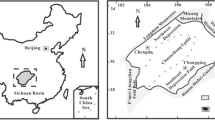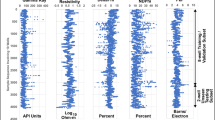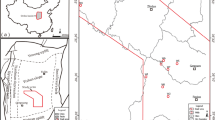Abstract
In this study, integrated approaches based on multivariate analysis (MVA), machine learning (ML), and geochemical analysis are proposed to investigate the potential of hydrocarbon reserves and total organic carbon (TOC) prediction. These approaches employed the MVA technique as a future selection method in source rock evaluation. We used geochemical data from 30 core samples taken equally from wells SS-5 and SS-7. Geochemical parameters, namely TOC, free hydrocarbon, thermal pyrolysis hydrocarbon, hydrogen index, production index, and oxygen index, were determined for statistical evaluation. IBM SPSS statistical software and MATLAB (R2020a) were used for MVA and ML, respectively. The performance of the models built using MVA and ML were evaluated by, among others, coefficient of determination (R2) and mean square error (MSE). Findings revealed that fair through good to excellent source rock with TOC ranging from 0.85 to 2.95 wt% are hosted in the Triassic beds of Tanga. A high 1.61% Ro at a mature peak of 463 °C predominates with the existence of type III/II kerogen that can produce both oil and gas. Considering TOC prediction from conventional well log data, optimized Gaussian process regression showed the best performance followed by MVA and support vector machine, giving the MSEs of 0.5629, 0.6172, and 0.7023, respectively. In terms of prediction accuracy, their R2 values of 0.952, 0.9346, and 0.835, respectively, were in good agreement with the geochemical results. The concurrence of geochemical analysis, ML, and MVA revealed that the Tanga basin has great hydrocarbon potential of great economic importance. The study revealed that combining MVA and other methods can be applied to assess the hydrocarbon resource potential of other prospects around the globe.






source rock














Similar content being viewed by others
References
Al-Mohair, H. K., Saleh, J. M., & Suandi, S. A. (2015). Hybrid human skin detection using neural network and K-means clustering technique. Applied Soft Computing, 33, 337–347.
Alquisom, M. M. (2016). Development of an artificial neural network based expert system to determine the location of horizontal well in a three-phase reservoir with a simultaneous gas cap and bottom water drive.
Amiri Bakhtiar, H., Telmadarreie, A., Shayesteh, M., Heidari Fard, M. H., Talebi, H., & Shirband, Z. (2011). Estimating total organic carbon content and source rock evaluation, applying ΔlogR and neural network methods: Ahwaz and Marun oilfields, SW of Iran. Petroleum Science and Technology, 29(16), 1691–1704.
Asante-Okyere, S., Shen, C., Ziggah, Y. Y., Rulegeya, M. M., & Zhu, X. (2020). A novel hybrid technique of integrating gradient-boosted machine and clustering algorithms for lithology classification. Natural Resources Research, 29(4), 2257–2273. https://doi.org/10.1007/s11053-019-09576-4
Azimi-Pour, M., Eskandari-Naddaf, H., & Pakzad, A. (2020). Linear and non-linear SVM prediction for fresh properties and compressive strength of high volume fly ash self-compacting concrete. Construction and Building Materials, 230, 117021. https://doi.org/10.1016/j.conbuildmat.2019.117021
Aziz, H., Ehsan, M., Ali, A., Khan, H. K., & Khan, A. (2020). Hydrocarbon source rock evaluation and quantification of organic richness from correlation of well logs and geochemical data: A case study from the sembar formation, Southern Indus Basin, Pakistan. Journal of Natural Gas Science and Engineering, 81, 103433. https://doi.org/10.1016/j.jngse.2020.103433
Behar, F., Beaumont, V., & Penteado, H. L. D. B. (2001). Rock-Eval 6 technology: Performances and developments. Oil & Gas Science and Technology, 56(2), 111–134.
Bolandi, V., Kadkhodaie, A., & Farzi, R. (2017). Analyzing organic richness of source rocks from well log data by using SVM and ANN classifiers: A case study from the Kazhdumi formation, the Persian Gulf basin, offshore Iran. Journal of Petroleum Science and Engineering, 151, 224–234.
Bramer, M. (2016). Data for data mining. Principles of data mining pp. 9–19. Springer.
Carvajal-Ortiz, H., & Gentzis, T. (2015). Critical considerations when assessing hydrocarbon plays using Rock-Eval pyrolysis and organic petrology data: Data quality revisited. International Journal of Coal Geology, 152, 113–122.
Dembicki, H., Jr. (2009). Three common source rock evaluation errors made by geologists during prospect or play appraisals. AAPG Bulletin, 93(3), 341–356.
Edwards, D. S., Struckmeyer, H. I. M., Bradshaw, M. T., & Skinner, J. E. (1999). Geochemical characteristics of Australia’s southern margin petroleum systems. The APPEA Journal, 39(1), 297–321.
El Hajj, L., Baudin, F., Littke, R., Nader, F. H., Geze, R., Maksoud, S., & Azar, D. (2019). Geochemical and petrographic analyses of new petroleum source rocks from the onshore upper jurassic and lower cretaceous of Lebanon. International Journal of Coal Geology, 204, 70–84.
El Kammar, M. M. (2015). Source-rock evaluation of the Dakhla Formation black shale in Gebel Duwi, Quseir area Egypt. Journal of African Earth Sciences, 104, 19–26.
El Nady, M. M., Lotfy, N. M., Ramadan, F. S., & Hammad, M. M. (2015a). Evaluation of organic matters, hydrocarbon potential and thermal maturity of source rocks based on geochemical and statistical methods : Case study of source rocks in Ras Gharib oilfield, central Gulf of Suez Egypt. Egyptian Journal of Petroleum, 24(2), 203–211. https://doi.org/10.1016/j.ejpe.2015.05.012
El Nady, M. M., Ramadan, F. S., Hammad, M. M., & Lotfy, N. M. (2015b). Evaluation of organic matters, hydrocarbon potential and thermal maturity of source rocks based on geochemical and statistical methods: Case study of source rocks in Ras Gharib oilfield, central Gulf of Suez Egypt. Egyptian Journal of Petroleum, 24(2), 203–211.
Gentzis, T. (2018). International Journal of Coal Geology Geochemical screening of source rocks and reservoirs : The importance of using the proper analytical program. International Journal of Coal Geology, 190, 56–69. https://doi.org/10.1016/j.coal.2017.11.014
Giannakopoulou, P., Petrounias, P., Tsikouras, B., Kalaitzidis, S., Rogkala, A., Hatzipanagiotou, K., & Tombros, S. (2018). Using factor analysis to determine the interrelationships between the engineering properties of aggregates from igneous rocks in Greece. Minerals, 8(12), 580.
Godfray, G., & Seetharamaiah, J. (2019). Geochemical and well logs evaluation of the Triassic source rocks of the Mandawa basin, SE Tanzania: Implication on richness and hydrocarbon generation potential. Journal of African Earth Sciences, 153, 9–16.
Golden, C. E., Rothrock, M. J., Jr., & Mishra, A. (2019). Comparison between random forest and gradient boosting machine methods for predicting Listeria spp. prevalence in the environment of pastured poultry farms. Food Research International, 122, 47–55.
Hakimi, M. H., Abdullah, W. H., & Ahmed, A. F. (2017). Organic geochemical characteristics of oils from the offshore Jiza-Qamar Basin, Eastern Yemen: New insight on coal/coaly shale source rocks. Journal of Petroleum Science and Engineering, 153, 23–35.
Handhal, A. M., Al-Abadi, A. M., Chafeet, H. E., & Ismail, M. J. (2020). Prediction of total organic carbon at Rumaila oil field, Southern Iraq using conventional well logs and machine learning algorithms. Marine and Petroleum Geology, 116, 104347. https://doi.org/10.1016/j.marpetgeo.2020.104347
Hazra, B., Dutta, S., & Kumar, S. (2017). TOC calculation of organic matter rich sediments using Rock-Eval pyrolysis: Critical consideration and insights. International Journal of Coal Geology, 169, 106–115. https://doi.org/10.1016/j.coal.2016.11.012
Izenman, A. J. (2008). Modern multivariate statistical techniques. Regression, Classification and Manifold Learning, 10, 970–978.
Johnson, R. A., & Wichern, D. W. (2002). Applied multivariate statistical analysis (Vol. 5, Issue 8). Prentice hall Upper Saddle River, NJ.
Kaloop, M. R., Kumar, D., Samui, P., Hu, J. W., & Kim, D. (2020). Compressive strength prediction of high-performance concrete using gradient tree boosting machine. Construction and Building Materials, 264, 120198.
Kapilima, S. (2003). Tectonic and sedimentary evolution of the coastal basin of Tanzania during the Mesozoic times. Tanzania Journal of Science, 29(1), 1–16.
Lafargue, E., Marquis, F., & Pillot, D. (1998). Rock-Eval 6 applications in hydrocarbon exploration, production, and soil contamination studies. Revue De L’institut Français Du Pétrole, 53(4), 421–437.
Landau S.E., & Brian, S. (2004). Handbook of statistical analyses using SPSS program.
Langford, F. F., & Blanc-Valleron, M.-M. (1990). Interpreting Rock-Eval pyrolysis data using graphs of pyrolizable hydrocarbons vs total organic carbon (1). AAPG Bulletin, 74(6), 799–804.
Li, M., Chen, Z., Cao, T., Ma, X., Liu, X., & Li, Z. (2018). International journal of coal geology expelled oils and their impacts on rock-eval data interpretation, Eocene Qianjiang formation in Jianghan Basin, China. International Journal of Coal Geology, 191, 37–48. https://doi.org/10.1016/j.coal.2018.03.001
Mahmoud, A. A., Elkatatny, S., Ali, A., Abouelresh, M., & Abdulraheem, A. (2019). New robust model to evaluate the total organic carbon using fuzzy logic. SPE Kuwait Oil & Gas Show and Conference.
Mahmoud, A. A., Elkatatny, S., Ali, A., Abdulraheem, A., & Abouelresh, M. (2020). Estimation of the total organic carbon using functional neural networks and support vector machine. International Petroleum Technology Conference 2020, IPTC 2020. https://doi.org/10.2523/iptc-19659-ms
Mashhadi, Z. S., & Rabbani, A. R. (2015). International journal of coal geology organic geochemistry of crude oils and cretaceous source rocks in the iranian sector of the Persian Gulf : An oil – oil and oil – source rock correlation study. International Journal of Coal Geology, 146, 118–144. https://doi.org/10.1016/j.coal.2015.05.003
Mbede, E. I., & Dualeh, A. (1997). The coastal basins of Somalia, Kenya and Tanzania. In Sedimentary Basins of the World (Vol. 3, pp. 211–233). Elsevier.
Mulashani, A. K., Shen, C., Asante-okyere, S., Kerttu, P. N., & Abelly, E. N. (2021a). Group Method of Data Handling ( GMDH ) Neural Network for Estimating Total Organic Carbon ( TOC ) and hydrocar- bon potential distribution ( S 1, S 2) using well logs. Natural Resources Research. https://doi.org/10.1007/s11053-021-09908-3
Mulashani, A. K., Shen, C., Nkurlu, B. M., Mkono, C. N., & Kawamala, M. (2021b). Enhanced group method of data handling (GMDH) for permeability prediction based on the modified Levenberg Marquardt technique from well log data. Energy, 121915. https://doi.org/10.1016/j.energy.2021.121915
Omran, A. A., & Alareeq, N. M. (2018). Joint geophysical and geochemical evaluation of source rocks–A case study in Sayun-Masila basin Yemen. Egyptian Journal of Petroleum, 27(4), 997–1012.
Pan, S., Horsfield, B., Zou, C., Yang, Z., & Gao, D. (2017). Statistical analysis as a tool for assisting geochemical interpretation of the upper triassic yanchang formation, Ordos Basin, Central China. International Journal of Coal Geology, 173, 51–64.
Peters, K. E. (1986). Guidelines for evaluating petroleum source rock using programmed pyrolysis. AAPG Bulletin, 70(3), 318–329.
Priddy, K. L., & Keller, P. E. (2005). Artificial neural networks: an introduction (Vol. 68). SPIE press.
Robison, C. R. (1997). Hydrocarbon source rock variability within the Austin chalk and Eagle Ford shale (upper cretaceous), East Texas, USA. International Journal of Coal Geology, 34(3–4), 287–305.
Romero-Sarmiento, M.-F., Euzen, T., Rohais, S., Jiang, C., & Littke, R. (2016). Artificial thermal maturation of source rocks at different thermal maturity levels: Application to the Triassic Montney and Doig formations in the Western Canada Sedimentary Basin. Organic Geochemistry, 97, 148–162.
Romero-sarmiento, M., Ramiro-ramirez, S., Berthe, G., Fleury, M., & Littke, R. (2017). International journal of coal geology geochemical and petrophysical source rock characterization of the Vaca Muerta formation, Argentina : Implications for unconventional petroleum resource estimations. International Journal of Coal Geology, 184, 27–41. https://doi.org/10.1016/j.coal.2017.11.004
Rui, J., Zhang, H., Ren, Q., Yan, L., Guo, Q., & Zhang, D. (2020). TOC content prediction based on a combined Gaussian process regression model. Marine and Petroleum Geology, 118, 104429. https://doi.org/10.1016/j.marpetgeo.2020.104429
Said, A., Moder, C., Clark, S., & Abdelmalak, M. M. (2015). Sedimentary budgets of the Tanzania coastal basin and implications for uplift history of the East African rift system. Journal of African Earth Sciences, 111, 288–295.
Shalaby, M. R., Jumat, N., Lai, D., & Malik, O. (2019). Integrated TOC prediction and source rock characterization using machine learning, well logs and geochemical analysis: Case study from the Jurassic source rocks in Shams Field, NW Desert Egypt. Journal of Petroleum Science and Engineering, 176, 369–380. https://doi.org/10.1016/j.petrol.2019.01.055
Shen, C., Asante-Okyere, S., Yevenyo Ziggah, Y., Wang, L., & Zhu, X. (2019). Group method of data handling (GMDH) lithology identification based on wavelet analysis and dimensionality reduction as well log data pre-processing techniques. Energies, 12(8), 1509.
Suzuki, K. (2011). Artificial neural networks: methodological advances and biomedical applications. BoD–Books on Demand.
Temple, J. T. (1978). The use of factor analysis in geology. Journal of International Association of Mathematics and Geology, 10, 379–387.
Walden, J., Smith, J. P., & Dackombe, R. V. (1992). The use of simultaneous R-and Q-mode factor analysis as a tool for assisting interpretation of mineral magnetic data. Mathematical Geology, 24(3), 227–247.
Wang, J., Gao, Z., Kang, Z., Zhu, D., Liu, Q., Ding, Q., & Liu, Z. (2020). Geochemical characteristics, hydrocarbon potential and depositional environment of the Yangye Formation source rocks in Kashi sag, southwestern Tarim Basin, NW China. Marine and Petroleum Geology, 112, 104084.
Wopfner, H. (2002). Tectonic and climatic events controlling deposition in Tanzanian Karoo basins. Journal of African Earth Sciences, 34(3–4), 167–177.
Wu, G., Lü, Z. T., & Wu, Z. S. (2006). Strength and ductility of concrete cylinders confined with FRP composites. Construction and Building Materials, 20(3), 134–148.
Wu, X., Chen, Y., Zhao, G., Du, X., Zeng, H., Wang, P., Wang, Y., & Hu, Y. (2017). Evaluation of source rocks in the 5th member of the Upper Triassic Xujiahe formation in the Xinchang gas field, the Western Sichuan depression China. Journal of Natural Gas Geoscience, 2(4), 253–262.
Xie, Y., Zhu, C., Zhou, W., Li, Z., Liu, X., & Tu, M. (2018). Evaluation of machine learning methods for formation lithology identification: A comparison of tuning processes and model performances. Journal of Petroleum Science and Engineering, 160, 182–193.
Zaremotlagh, S., Hezarkhani, A., & Sadeghi, M. (2016). Detecting homogenous clusters using whole-rock chemical compositions and REE patterns: A graph-based geochemical approach. Journal of Geochemical Exploration, 170, 94–106. https://doi.org/10.1016/j.gexplo.2016.08.017
Zhou, D., Chang, T., & Davis, J. C. (1983). Dual extraction ofR-mode andQ-mode factor solutions. Journal of the International Association for Mathematical Geology, 15(5), 581–606.
Zumberge, J. E. (1987). Prediction of source rock characteristics based on terpane biomarkers in crude oils: A multivariate statistical approach. Geochimica Et Cosmochimica Acta, 51(6), 1625–1637.
Acknowledgments
This work was supported by the Major National Science and Technology Programs in the “Thirteenth Five-Year” Plan period (No. 2017ZX05032-002-004), National Natural Science Foundation China (grant Nos.41972326 and 51774258), and the Fundamental Research Fund for the Central Universities, China University of Geosciences (Wuhan, No. CUGCJ1820). Department of Petroleum Engineering and International Education College at the China University of Geosciences provided helps for the success of this experimental study.
Author information
Authors and Affiliations
Corresponding authors
Rights and permissions
About this article
Cite this article
Nyakilla, E.E., Silingi, S.N., Shen, C. et al. Evaluation of Source Rock Potentiality and Prediction of Total Organic Carbon Using Well Log Data and Integrated Methods of Multivariate Analysis, Machine Learning, and Geochemical Analysis. Nat Resour Res 31, 619–641 (2022). https://doi.org/10.1007/s11053-021-09988-1
Received:
Accepted:
Published:
Issue Date:
DOI: https://doi.org/10.1007/s11053-021-09988-1





